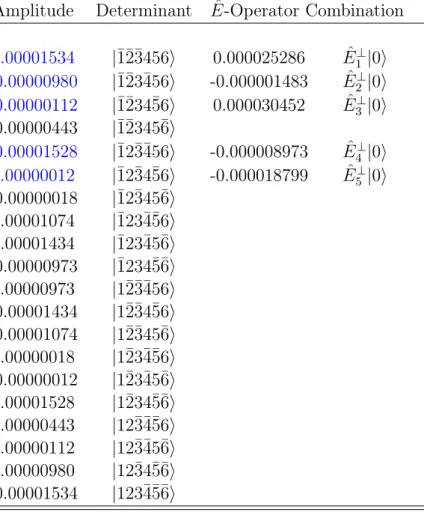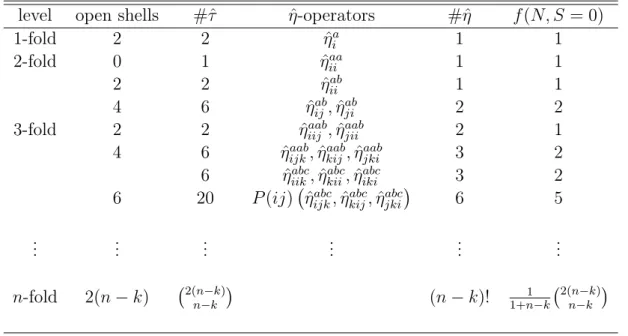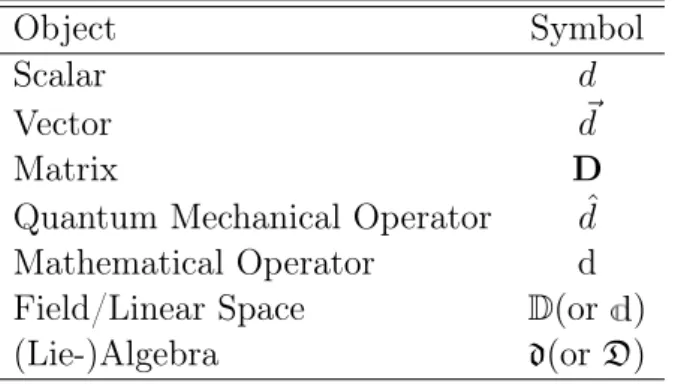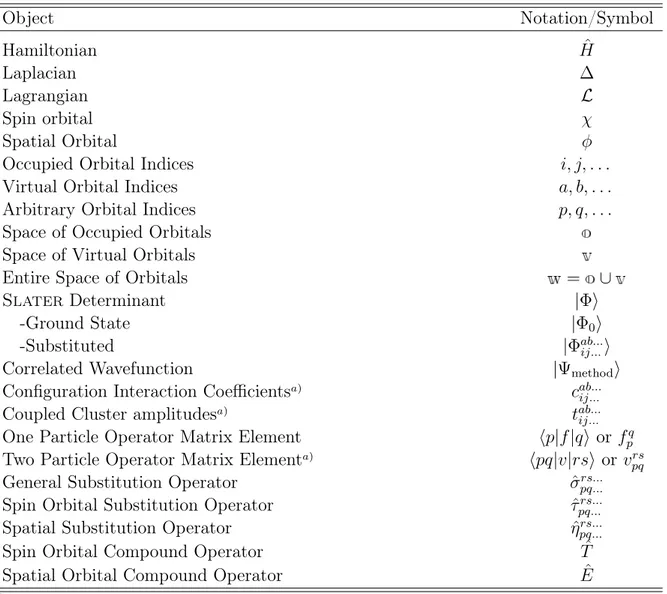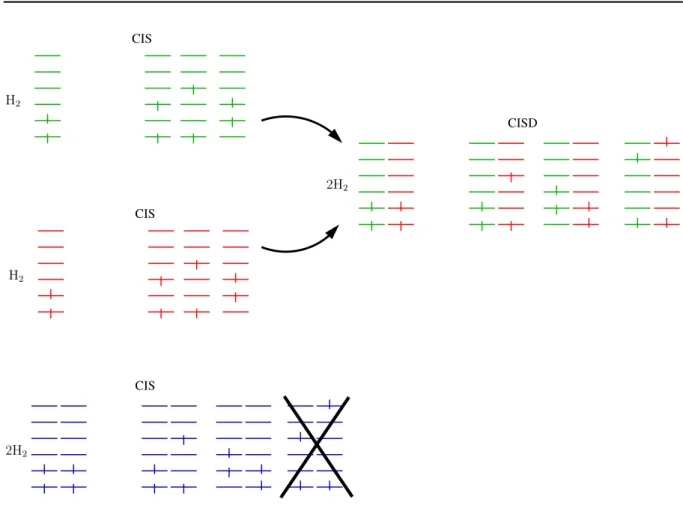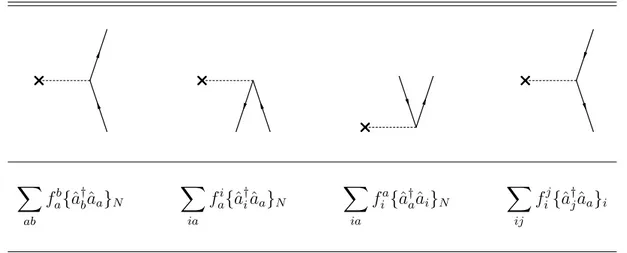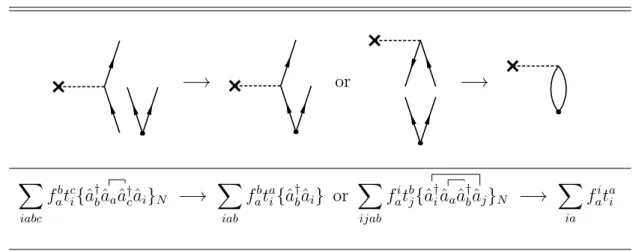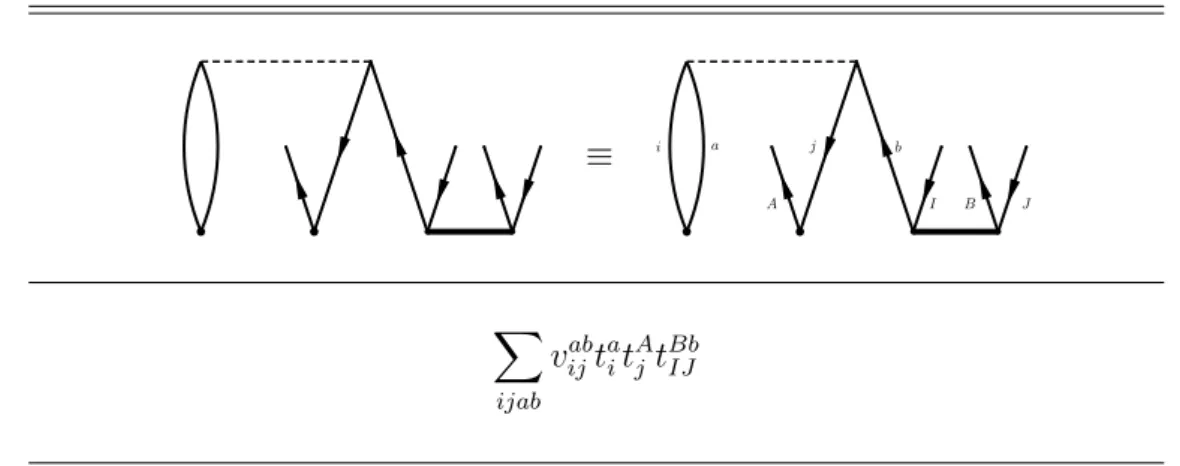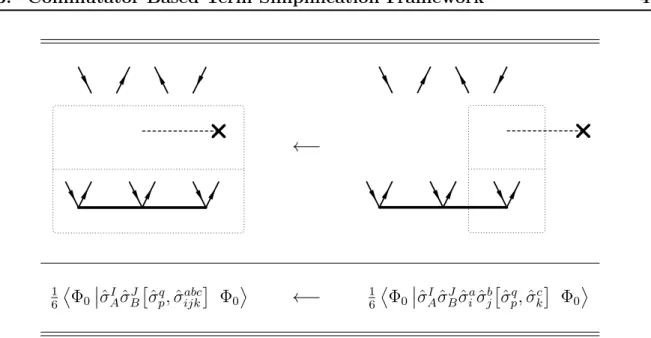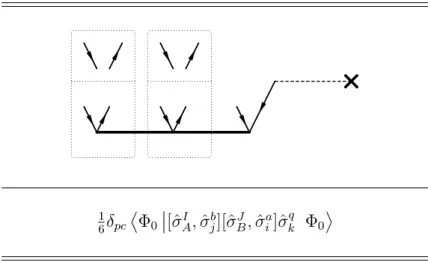An Alternative Algebraic Framework for the Simplication of Coupled Cluster Type Expectation Values
Inaugural-Dissertation
zur
Erlangung des Doktorgrades
der Mathematisch-Naturwissenschaftlichen Fakultät der Universität zu Köln
vorgelegt von Daniel Pape
aus Bensberg
Köln 2013
Priv.-Doz. Dr. Michael Hanrath
Tag der mündlichen Prüfung: 17. Oktober 2013
»’Drink up.’ He added, perfectly factually: ’The world’s about to end.’ [. . . ] ’This must be Thursday,’ said Arthur to himself, sinking low over his beer, ’I never could get the
hang of Thursdays.’«
Dialog between Ford Prefect and Arthur Dent, in ’The Hitchhikers Guide to the Galaxy’ by Douglas Adams.
Meinen Eltern
Contents
1 Introduction 11
1.1 Historical Notes . . . 11
1.1.1 The Coupled Pair Many Electron Theory . . . 11
1.2 State of the Art in Coupled Cluster Theory . . . 11
1.2.1 Truncated Versions of the Theory . . . 12
1.2.2 Multi Reference Generalizations of the Theory . . . 12
1.3 Scope of This Work . . . 13
1.3.1 Motivation . . . 13
1.3.2 Theoretical Aspects . . . 15
1.3.3 Implementational Aspects . . . 15
1.4 Technical and Notational Remarks . . . 15
2 Introductory Theory 17 2.1 The Electronic Structure Problem . . . 18
2.1.1 The Schrödinger Equation . . . 18
2.1.2 The Electronic Hamiltonian . . . 18
2.1.3 Electron Correlation . . . 19
2.2 Wavefunction Based Approaches . . . 19
2.2.1 The Independent Particle Model . . . 19
2.2.1.1 Slater Determinants . . . 20
2.2.1.2 Hartree-Fock Approach . . . 21
2.2.1.3 Restricted Hartree-Fock . . . 22
2.2.2 Many-Body Expansion of the Wavefunction . . . 23
2.2.2.1 Linear Expansion: Conguration Interaction . . . 23
2.2.2.2 Full CI and Truncated CI Versions . . . 24
2.2.3 Size Consistency and the Product Expansion . . . 25
2.2.4 Algebraic Properties of the Expansion Coecients . . . 26
3 Coupled Cluster Theory 27 3.1 Introduction . . . 27
3.1.1 The Coupled Cluster Wavefunction . . . 27
3.1.2 The Projected Schrödinger Equation . . . 28
3.1.3 Size Extensivity . . . 29
3.2 Algebraic Framework . . . 29
3.2.1 The Concept of Normal Order . . . 29
3.2.1.1 Particle-Hole Formalism . . . 30
3.2.1.2 The Normal Ordered Hamiltonian . . . 31
3.2.2 The Baker-Campbell-Hausdorff Expansion . . . 33
3.3 Diagrammatic Approach to Coupled Cluster Theory . . . 34
3.3.1 Denitions . . . 34
3.3.2 Precontracted Diagrams . . . 36
3.3.3 Generation of the Coupled Cluster Equations Employing Diagrams 36 3.4 Spin Independent Coupled Cluster in the Literature . . . 38
3.4.1 Diagrammatic Approaches . . . 38
3.4.2 Algebraic Approaches . . . 39
4 An Alternative Algebraic Framework 41 4.1 Denitions and Notational Remarks . . . 41
4.1.1 Remark on the Name Unitary Group Generators . . . 43
4.2 Normal Ordering of Substitution Operators . . . 43
4.3 Commutator Based Term Simplication Framework . . . 46
4.3.1 Spatial Orbital Substitution Operators in Wick’s Theorem . . . 46
4.3.2 Evaluation of Nested Commutator Expressions . . . 47
4.3.3 Diagrammatic Representation . . . 49
4.3.3.1 Example Involving Triple Excitations . . . 49
4.3.3.2 A Note on Tensor Symmetries . . . 52
4.3.3.3 Note on the Applicability to the CI Problem . . . 55
4.3.3.4 Summary . . . 57
5 Implementation 59 5.1 General Considerations . . . 60
5.1.1 Status Quo . . . 60
5.2 Basic Algorithm . . . 61
5.3 Design Concepts and Realization . . . 64
5.3.1 Polymorphism . . . 64
5.3.2 Expression Handling . . . 64
5.3.2.1 The expand() Command . . . 65
5.3.2.2 The sortProducts() Command . . . 66
5.3.2.3 The collect() Command . . . 66
5.3.3 The ExpressionListCommutator Class . . . 66
5.3.3.1 Tree Structures . . . 67
5.3.3.2 Algebraic Term Simplication . . . 68
5.3.4 Polymorphism Implementation . . . 69
5.4 Input and Output Syntax . . . 71
5.4.1 Syntax for Compound Operator Expressions . . . 71
5.4.1.1 Canonical Syntax for Commutator Expressions . . . 71
5.4.2 Output Syntax . . . 71
5.4.2.1 Example Program Outputs . . . 71
5.5 The SICluster Term Simplication Program . . . 73
5.5.1 The evaluateSingleCommutators Function . . . 75
Contents vii
5.5.2 The generateNewCommutators Function . . . 76
5.6 Computational Demand . . . 78
5.6.1 Theoretical Considerations . . . 78
5.6.2 Measurements . . . 81
5.6.2.1 Projection Levels . . . 81
5.6.2.2 Position of Product Operators . . . 83
5.6.2.3 Commutator Depth . . . 83
6 Conclusion 85
Bibliography 87
A Danksagung 93
B Erklärung 95
C Lebenslauf 97
Kurzzusammenfassung
Das Coupled-Cluster-Verfahren zählt zu den am häugsten angewandten und ef- zientesten Korrelationsverfahren in der Quantenchemie. Insbesondere die CCSD(T)- Näherung, in der der Cluster-Operator auf Einfach- und Zweifachsubstitutionen (Singles und Doubles) der Referenzdeterminante beschränkt wird und die störungstheoretis- che Dreifachanregungsenergie (Triples) addiert wird, ist zum Standard der Quanten- chemie geworden. Allerdings beschränkt sich diese Methode aufgrund ihrer ungünsti- gen Skalierung (N7, wobei N der Anzahl der Basisfunktionen entspricht) auf vergleich- sweise kleine Systeme. Für die volle Behandlung der Dreifachanregungen skaliert der Rechenaufwand bereits mit N8, für jeden weiteren Anregungsgrad erhöht sich der Expo- nent um weitere zwei.
Durch diese Arbeit soll es möglich werden, die Rechenzeit für beliebige Anregungs- grade im Falle geschlossener Elektronenschalen zumindest um einen mit steigendem An- regungsgrad wachsenden Faktor zu reduzieren. Hierzu wird davon ausgegangen, dass der Raumteil jeweils zweier Spinorbitale gleich ist, sodass in den Anregungen die beiden möglichen Spinzustände gleich behandelt werden können. Während die dadurch entste- henden Restriktionen für die Cluster-Amplituden im CCSD noch durch einfache Spininte- gration konstruiert werden können, müssen die Einschränkungen für höhere Anregungen über die Betrachtung der Raumorbitalanregungsoperatoren Eˆ hergeleitet werden.
Im ersten Teil der Arbeit wird ein allgemeines Schema zur Konstruktion der spingemit- telten Cluster-Amplituden und Projektionsgleichungen zu deren numerischer Bestimmung entwickelt, das über die CCSD-Näherung hinaus geht. Der zweite Teil der Arbeit besteht aus der Implementierung der Ergebnisse des ersten Teils in einen schon bestehenden ef- zienten CC-Programmcode.
Abstract
The Coupled-Cluster (CC) method is one of the most popular and ecient correlation methods in quantum chemistry. Especially the CCSD(T) approximation, which includes single and double excitations by means of the application of the cluster operator to a reference determinant and triple excitations via a perturbative treatment, has become a standard tool in quantum chemical applications. However, the method is restricted to relatively small system sizes due to its unfavourable scaling (N7, whereN is the number of basis functions applied). For the full treatment of triple excitations the scaling advances to N8 and every further excitation level increases the exponent by two.
The goal of this work is to reduce the calculation time for closed shell systems at least by a factor growing with the excitation level for arbitrary truncation levels. This is done by restricting the spatial parts of the spin orbitals and thus treat pairs of spin orbitals on the same footing. The restrictions can be easily constructed for the CCSD model by spin integration. The derivation of the restrictions arising in higher excited case will be done employing the spatial orbital excitation operators E.ˆ
In the rst part of this work an algorithm is derived that is capable of the derivation of the energy and amplitude equations for arbitrary excitation levels. In the second part an implementation of this algorithm is presented.
List of Figures
2.1 Scheme of a CIS calculation of a system of two independent hydrogen molecules in contrast to two separate CIS calculations of the individual fragments. . . 25 3.1 Picture of the diagrams contributing to the Fockoperator. . . . 35 3.2 Two possible contractions of theFock operator with a single substitution
operator. . . 36 3.3 Scheme of the two-particle contributions to the Fock operator. . . 37 3.4 Example of a doubles projection diagram of the two particle part of the
normal ordered Hamiltonian. . . 37 4.1 Diagrammatic representation of the initial expansion step of the algebraic
term simplication. . . 49 4.2 Diagrammatic representation of an already singly contracted term turning
up as an intermediate. . . 51 4.3 Diagrammatic representation of an intermediate term containing two non-
nested commutators. . . 51 4.4 Diagrammatic representation of a fully contracted term. . . 52 4.5 Weighted and maximum loop rule violating diagrams for the singles pro-
jection of [ ˆFN,Tˆ2]. . . 55 5.1 Scheme of the static term simplication included in the QOL. . . 61 5.2 UML class diagram for the dynamic expression handling as used in this work. 65 5.3 Tree representation of a nested expression before simplication. . . . 69 5.4 Tree representation of a nested expression after simplication. . . 69 5.5 UML class diagram for the main dependencies in the dynamic term sim-
plication. . . 70 5.6 Program Output for spin orbitals. . . 72 5.7 Program output for spatial orbitals. . . 74
List of Tables
1.1 Construction of triples amplitudes from linear combinations of spin inde- pendent amplitudes. . . . 13 1.2 Independent operators and number of singlet spin functions for dierent
excitation levels and numbers of open shells. . . 14 1.3 Typesetting of mathematical objects throughout this work. . . 15 1.4 Conventions for the notation of special objects in many body theory. . . . 16 3.1 Fragments occurring in coupled cluster Goldstonediagrams. . . 35 5.1 Total CPU time and maximum number of terms involved in the simpli-
cation of three dierent projections. . . 82 5.2 Timing analysis for a single module run. The results for Wick’s theorem
are obtained from table 5.1 with a scaling factor of 2nop. . . 82 5.3 Dependency of the maximal number of terms on altering the position of a
two particle substitution. . . 83 5.4 Comparison of the timing analyses for 100 module runs employing nested
commutator expressions. . . 83
Listings
5.1 Algorithm for the term simplication. . . 63
Chapter 1
Introduction
Contents
1.1 Historical Notes . . . 11
1.1.1 The Coupled Pair Many Electron Theory . . . 11
1.2 State of the Art in Coupled Cluster Theory . . . 11
1.2.1 Truncated Versions of the Theory . . . 12
1.2.2 Multi Reference Generalizations of the Theory . . . 12
1.3 Scope of This Work . . . 13
1.3.1 Motivation . . . 13
1.3.2 Theoretical Aspects . . . 15
1.3.3 Implementational Aspects . . . 15
1.4 Technical and Notational Remarks . . . 15
1.1 Historical Notes
The coupled cluster (CC) method was invented by Coester and Kümmel [1, 2] in the late 1950s as a method for nuclear physics. However, the inventors regarded their method as inapplicable in their eld. In 1966ížek[3, 4, 5] introduced the CC theory in quantum chemistry as coupled pair many electron theory (CPMET).
1.1.1 The Coupled Pair Many Electron Theory
In his ansatz ížekapplied an exponential wave operator including all powers of double substitution operators, by means of its Taylorexpansion, to the ground state Slater- determinant and evaluated algebraic equations in terms of powers of the coecients (am- plitudes) of the substituted determinants. In his approach he employed both the spin orbital and the spatial orbital framework.
1.2 State of the Art in Coupled Cluster Theory
Despite its high computational complexity coupled cluster theory emerged into a widely used tool for computational chemists [6, 7, 8]. In particular truncated versions of the theory, namely coupled cluster singles and doubles (CCSD) and its perturbationally aug- mented form (CCSD(T)) [9], have become popular and are implemented in many ab
initio electronic structure program codes such as MOLPRO [10], MOLCAS [11] or TUR- BOMOLE [12].
Especially the CCSD(T) ansatz emerged as the gold standard of quantum chemistry for energies as well as properties including dipole moments, gradients [13] or chemical shifts for nuclear magnetic resonance spectroscopy [14, 15, 16, 17].
1.2.1 Truncated Versions of the Theory
A hierarchy of methods with increasing accuracy and complexity has evolved in the past.
The truncation of the cluster operator at dierent substitution levels leads to a series of methods which produce energies that converge to the full conguration interaction (FCI) limit in a very fast way (i.e. substantially faster than the conguration interaction series of methods). Implementations for various truncation levels are known, such as CCSDT [18, 19, 20], CCSDTQ [21] and CCSDTQP [22, 23].
Due to the high complexity of both the derivation as well as the solution of the algebraic equations dened by the setup of the CC ansatz, implementations often restrict themselves to truncated versions of the theory. The program package MOLPRO for example can only handle up to double excitations in the cluster operator. Even triple excitations are handled on a perturbational level only. Up to now, the author is aware of only a few codes capable of the generation and solution of general order coupled cluster equations with the correct scaling [24, 25, 26, 27, 28, 29].
1.2.2 Multi Reference Generalizations of the Theory
In contrast to the conguration interaction (CI) method1, a multi reference genraliztion of the coupled cluster ansatz is neither straightforward nor unique and mainly two dierent classes of approaches have been developed. The rst one is the valence universal method of Mukherjee and co-workers [30, 31, 32, 33, 34], the second one is the state universal approach of Jeziorski and Monkhorst [35, 36, 37, 38, 39, 40], which at the moment has a huge number of so-called state specic variants [41, 42, 43, 44].
Both original ansätze showed to be not very accurate, since in their working equa- tions the expansion coecients (amplitudes) are shared for several states. This leads to a smaller exibility of the wavefunction per state. Furthermore, especially for many ref- erence states the possibility of diverging cluster operators is given, commonly known as the intruder state problem.
These are the reasons for the development of the state specic ansätze mentioned above. However, research in thiseld is still in progress. Presently, the author is not aware of a genuine multi reference coupled cluster ansatz that is truly satisfactory, meaning a method combining the properties of the single reference coupled cluster ansatz with a true generalization to more than one reference wavefunction.
1The conguration interaction method employs a linear expansion of the wavefunction in the many particle basis set. For details see sec. 2.2.2.1.
1.3. Scope of This Work 13
1.3 Scope of This Work
The following section contains an overview over the goals of this work. It has mainly two aspects, namely a theoretical and an implementational, which will be dealt with separately. A nal chapter will discuss the numerical testing of the concepts and the implementation presented.
Table 1.1: Construction of triples amplitudes from linear combinations of spin indepen- dent amplitudes. Calculation via a linear equation system employing the blue colored amplitudes. The amplitudes are taken from a CCSDT calculation of the Li2 molecule at an interatomic distance of 3.5 a.u. employing a 6-31Gp basis set [45].
Amplitude Determinant E-Operator Combinationˆ 0.00001534 |¯1¯2¯3456 0.000025286 Eˆ1|0 -0.00000980 |¯1¯23¯456 -0.000001483 Eˆ2|0 -0.00000112 |¯1¯234¯56 0.000030452 Eˆ3|0 -0.00000443 |¯1¯2345¯6
-0.00001528 |¯12¯3¯456 -0.000008973 Eˆ4|0 0.00000012 |¯12¯34¯56 -0.000018799 Eˆ5|0 -0.00000018 |¯12¯345¯6
0.00001074 |¯123¯4¯56 0.00001434 |¯123¯45¯6 -0.00000973 |¯1234¯5¯6 0.00000973 |1¯2¯3¯456 -0.00001434 |1¯2¯34¯56 -0.00001074 |1¯2¯345¯6 0.00000018 |1¯23¯4¯56 -0.00000012 |1¯23¯45¯6 0.00001528 |1¯234¯5¯6 0.00000443 |12¯3¯4¯56 0.00000112 |12¯3¯45¯6 0.00000980 |12¯34¯5¯6 -0.00001534 |123¯4¯5¯6
1.3.1 Motivation
There are many ecient coupled cluster implementations existing already. Most of these implementations include at most doubles substitutions (and perturbational triples). The probably fastest implementation of a closed shell CCSD code at the moment is included in the MOLPRO program package.
Table 1.2: Independent operators and number of singlet spin functions for dierent excitation levels and numbers of open shells.
level open shells #ˆ -operatorsˆ #ˆ f(N, S = 0)
1-fold 2 2 ˆai 1 1
2-fold 0 1 ˆiiaa 1 1
2 2 ˆabii 1 1
4 6 ˆabij,ˆjiab 2 2
3-fold 2 2 ˆiijaab,ˆaabjii 2 1
4 6 ˆaabijk,ˆkijaab,ˆjkiaab 3 2 6 ˆiikabc,ˆkiiabc,ˆabciki 3 2
6 20 P(ij)
ˆ
abcijk,ˆkijabc,ˆjkiabc
6 5
... ... ... ... ... ...
n-fold 2(nk) 2(nk)
nk
(nk)! 1+n1k2(nk)
nk
It is however noteworthy that no implementation of a closed shell spin independent coupled cluster code for arbitrary substitution levels exists, but very recently Stanton and Gauss reported the implementation of spin intependent versions of CCSDT and CCSDTQ [46, 47]. It is the scope of this work to develop an algebraic term simplica- tion capable of the derivation of spin independent coupled cluster equations for arbitrary substitution levels.
Upon inspection of the amplitudes (i.e. the expansion coecients in the many body basis set) obtained from a spin orbital coupled cluster program applied to a closed shell reference (tab. 1.1), it is clear that a lot of memory and time could be saved by the application of a spin independent code. Table 1.1 shows that e.g. the twenty spin orbital based amplitudes, resulting from a spin orbital based calculation of the Lithium dimer, can be constructed out of ve spin independent non-redundant amplitudes only (originating from the application of the orthogonalized spin independent operators Eˆi in the CC framework). This implies that the size of this part of the amplitude tensor as well as the residual tensor is in the spin independent case only one fourth of the original size. This results in an reduction in computational time of an even greater magnitude.
It is obvious that the ratio between the number of spin orbital based amplitudes and spin independent amplitudes grows with the maximal substitution level since the number of linear independent spin eigenfunctions does not grow as rapidly as the number of primitive spin functions as well as the number of substitution operators (see also tab.
1.2).
1.4. Technical and Notational Remarks 15
Table 1.3: Typesetting of mathematical objects throughout this work.
Object Symbol
Scalar d
Vector d
Matrix D
Quantum Mechanical Operator dˆ
Mathematical Operator d
Field/Linear Space D(or )
(Lie-)Algebra d(orD)
1.3.2 Theoretical Aspects
In the theoretical part of this work an alternative algebraic term simplication for coupled cluster type expectation values that has been developed is described. This new method relies on well known commutator relations for second quantized substitution operators and employs their characteristics as members of a Lie algebra.
1.3.3 Implementational Aspects
For the implementation of the algebraic term simplication several parts of the Quantum Objects Library (QOL, a program package used and developed by our group, initiated by Hanrath) had to be modied. Additionally, many new concepts and classes had to be implemented from scratch.
1.4 Technical and Notational Remarks
Throughout this work a consistent notation will be used. Scalar and vector (additionally marked by an over-rightarrow) quantities as well as quantum mechanical operators (ad- ditionally marked by a hat) are typeset in italic, matrices are typeset in boldface font.
Mathematical operators, such as the dierential operator, are typeset in an upright font.
Additionally there are several algebraic structures that have their own type: Fields and sometimes linear spaces are typeset in blackboard font whereas groups and algebras, especially Lie algebras, are typeset in fracture font.
It should be noted that, despite not fulllling the criteria for a linear space, basis sets are commonly called spaces in the literature. This notation will be adopted in this work and thus basis sets are also typed in blackboard font for convenience.
Many, more or less convenient, xed notations for distinct objects in many body theory have evolved in literature over time. In this work most of these conventions will be adapted. Table 1.4 gives an overview over the most common conventions.
It should be noted that lower case symbols refer to one particle quantities while upper case symbols refer to many particle quantities, e.g. | for a spatial orbital and | for a
Table 1.4: Conventions for the notation of special objects in many body theory.
Object Notation/Symbol
Hamiltonian Hˆ
Laplacian
Lagrangian L
Spin orbital
Spatial Orbital
Occupied Orbital Indices i, j, . . .
Virtual Orbital Indices a, b, . . .
Arbitrary Orbital Indices p, q, . . .
Space of Occupied Orbitals Space of Virtual Orbitals
Entire Space of Orbitals =
Slater Determinant |
-Ground State |0
-Substituted |ab...ij...
Correlated Wavefunction |method
Conguration Interaction Coecientsa) cab...ij...
Coupled Cluster amplitudesa) tab...ij...
One Particle Operator Matrix Element p|f|q orfpq
Two Particle Operator Matrix Elementa) pq|v|rs or vpqrs
General Substitution Operator ˆpq...rs...
Spin Orbital Substitution Operator ˆpq...rs...
Spatial Substitution Operator ˆrs...pq...
Spin Orbital Compound Operator Tˆ
Spatial Orbital Compound Operator Eˆ
a)Symmetry issues concerning the indices of the many particle operator matrix elements are discussed when necessary. In general no special symmetry is assumed for the matrix elements.
Slater determinant. This rule applies only for symbols where a dierentiation between the one and many body cases is necessary.
Finally, in chapter four a notation distinguishing between spin and spatial orbital indices is introduced. In this notation and beta spin oprbital indices are described by under- and overbars, respectively. A detailed introduction to this notation is postponed to the beginning of chapter four.
Chapter 2
Introductory Theory
Contents
2.1 The Electronic Structure Problem . . . 18 2.1.1 The Schrödinger Equation . . . 18 2.1.2 The Electronic Hamiltonian . . . 18 2.1.3 Electron Correlation . . . 19 2.2 Wavefunction Based Approaches . . . 19 2.2.1 The Independent Particle Model . . . 19 2.2.1.1 Slater Determinants . . . 20 2.2.1.2 Hartree-Fock Approach . . . 21 2.2.1.3 Restricted Hartree-Fock . . . 22 2.2.2 Many-Body Expansion of the Wavefunction . . . 23 2.2.2.1 Linear Expansion: Conguration Interaction . . . 23 2.2.2.2 Full CI and Truncated CI Versions . . . 24 2.2.3 Size Consistency and the Product Expansion . . . 25 2.2.4 Algebraic Properties of the Expansion Coecients . . . 26
This chapter contains a description of the central problem of quantum chemistry, i.e. the many body interaction of electrons in the potential provided by the positive charge of atomic nuclei [48]. After the description of the problem, the wavefunction based approach to the approximate solution of this problem is discussed. Herein the focus will lie on the description of electronic correlation methods, mainly conguration interaction and coupled cluster. The discussion of the coupled cluster formalism then leads to the main topic of this work, namely the setup of an algebraic framework for the derivation of spin independent coupled cluster equations.
The concepts described in this chapter are well known and included in many popular quantum chemistry textbooks, e.g. [49, 50, 51, 52, 53, 54].
2.1 The Electronic Structure Problem
The main problem electronic structure theory has to deal with is the pairwise repulsive electrostatic interaction of electrons. Approximations addressing this challenge will be formally described in the following sections.
2.1.1 The Schrödinger Equation
The quantum mechanical description of a system (assumed stationary over time) in a non-relativistic framework is provided by the time independent Schrödinger equation 2.1 [55, 56, 57, 58]:
Hˆ =E. (2.1)
Herein the wavefunction describes the considered system,Hˆ the Hamiltonian, con- taining operators for its kinetic and potential energy and E the energy of a valid state of the system.
Since the kinetic energy operator contains second derivatives of the wavefunction with respect to particle coordinates, theSchrödingerequation has to be considered a partial dierential equation of second order.
2.1.2 The Electronic Hamiltonian
The nuclei of a polyatomic system can be seen as quasi-stationary entities due to their mass which is at least three orders of magnitude greater than that of an electron. This results, assuming an evenly distributed kinetic energy, in a much smaller velocity and subsequently only a marginal contribution to the kinetic energy.
According to this analysis,rst carried out byBornandOppenheimer[59], a major simplication of the Hamiltonian can be achieved by neglecting the kinetic energy oper- ators regarding the nuclei. Furthermore the potential energy arising from the repulsion between nuclei can be evaluated via the classicalCoulomblaw by insertion of theirxed positions.
The preceding discussion gives rise to an electronic Hamiltonian Hˆel as described in eq. 2.21,
Hˆel =1 2
i
i
iI
ZI
riI +
i<j
1
rij , (2.2)
wherei, j are indices for electrons andI is the index for nuclei. ZI is the charge of nucleus I and r is the distance of two particles. TheLaplace operator i is dened by
1Throughout this work the convention of atomic units is used. In this framework, many constants occuring in quantum theory are set to unit values, e.g. =e=me=a0= 40= 1.
2.2. Wavefunction Based Approaches 19
i =2i = 2
x2i + 2
yi2 + 2
zi2 , (2.3)
where
ri = (xi, yi, zi) (2.4)
is the position vector of particle i.
2.1.3 Electron Correlation
Considering the last term of the electronic Hamiltonian in eq. 2.2, usually referred to as the inter-electronic Coulomb interaction, it is clear that the movement of the electrons is correlated.2 A similar eect is known in the physics of planetary movement, where the motion of dierent planets is coupled via the gravitational law3. Closed form solutions to both problems are only existent for a few well conditioned cases, e.g. the coupled motion of two particles, the motion of one particle in a central spherical symmetric potential, and certain cases involving three particles with specic boundary conditions.
On the other hand, it can be shown that an analytical solution to the problem exists in form of a converging power series [60]. Even before this remarkable result it was an established procedure to expand the approximate wavefunction into a linear combination of basis functions. The following sections will give an overview over the most popular approaches of this type.
2.2 Wavefunction Based Approaches
Wavefunction based approaches approximate the exact wavefunction in a basis of suited analytical functions. In contrast, there are (semi-)empirical models which adjust certain quantities occuring in the calculation of a system (e.g. integrals) to experimental data.
This type of approach will not be considered in this work.
2.2.1 The Independent Particle Model
As a crude rst approximation it is possible to partition the electronic Hamiltonian into a sum of eective4 one particle operators ˆhi:
Hˆel =
i
hˆi . (2.5)
2In the sense of mathematical correlation, i.e. the position of an electron is a function of the position of the other electrons. For correlation inLöwdin’s sense cf. section 3.2.2.
3In fact the potentials of electrostatic as well as gravitational interaction show the samer1 depen- dency .
4i.e. these operators may well be inuenced by the structure of the other single particle wave-functions, cf. section 2.2.1.2.
It can be shown by simple algebraic manipulations that the eigenfunction of such an operator must be a product of eigenfunctions to the individual one particle operators.
This product is known as the Hartree product of the one particle functions. The one particle functions involved in this expansion are usually referred to as spin orbitals:
i :R3 ×SC
(x,)i(x,), (2.6)
where x are the spatial and is the spin coordinate of the particle (S:={,}).
2.2.1.1 Slater Determinants
There are two severe drawbacks of this single product wavefunction ansatz regarding the nature of electrons. First of all, as any elementary particles, electrons are indistinguish- able, which the product wavefunction does not account for. The second drawback is due to the fermionic nature of the electrons. This requires the wavefunction to be antisymmetric with respect to the interchange of a pair of electrons. The only normalized, completely antisymmetric, n-linear form over a vector space (spanned by n orbitals) turns out to be the determinant (cf. e.g. [61], sec. 4.2). Thus, the wavefunction should be written as a so called Slater determinant [62]:
|= 1
n!det(i(j))i,j=1,...,n . (2.7)
Herein i denotes the ith spin-orbital and j is the coordinate vector of the jth electron.
Another, more formal way of writing a Slater determinant is
|= n!A
n i
i(i), (2.8)
where A is the antisymmetrizer, an idempotent operator dened by A= 1
n!
PˆiSn
(1)p( ˆPi)Pˆi . (2.9)
The Pˆi are the permutation operators ofn particles operating on the particle index. This variant in notation is commonly known as the Leibnizexpansion rule for determinants.
Since the determinant includes all permutations of the particle coordinates, one can easily see that the indistinguishability of the electrons in the probability density is now fullled. The parity p( ˆPi) of the ith permutation guarantees a sign change of the deter- minant when two electron coordinates are interchanged5.
Since now the physical requirements for a non-interacting system of electrons are satised, the Slater determinant is a common starting point for electronic structure calculations.
5This is in close analogy to the sign change of the determinant of a usual n×n-matrix when two columns are swapped.
2.2. Wavefunction Based Approaches 21
2.2.1.2 Hartree-Fock Approach
The Hartree-Fockapproach [63, 64] results from minimizing the expectation value of the electronic Hamiltonian with respect to the variation of the spin orbitals in a single Slater determinant:
E[{|i}] := |Hˆel|
|
=! min. (2.10)
When additionally the constraint is considered that the spin orbitals are required to stay orthonormal the problem leads to the minimization of the Lagrangian:
L[{|i}] =E[{|i}] +
ij
ij(ij i|j). (2.11)
Solving this variational problem in the basis which diagonalizes= (ij)i,j=1,...,n leads to a set of integro-dierential equations, one for each spin-orbital. These equations are called canonical Hartree-Fockequations:
fˆ|i=i|i (2.12)
with
fˆ= ˆh+ 1 2
N j=1
Jˆj Kˆj
(2.13) and
ˆh=1 2
i
i
iI
Zi
riI
, (2.14)
Jˆj|i(1)=j(2)|r112|j(2)|i(1), (2.15) Kˆj|i(1) =j(2)|r112|i(2)|j(1). (2.16) The operatorsJˆjandKˆjare calledCoulomband exchange operators, respectively. While the Coulomb operator models a sort of averaged electronic repulsion, the exchange op- erator has no classical analogue. However, when the indices iandj coincide the exchange operator cancels exactly the contribution of the Coulomboperator. This is, the interac- tion of an electron with itself is naturally cancelled. From the above equations 2.15 and 2.16 it becomes clear that the integro-dierential equation for each spin orbital depends on all other spin orbitals. This requires the solution to be of an iterative type, since the equations depend on their own solutions. The iterative solution is often referred to as self consistent eld (SCF) procedure, since a nal solution has to be stationary with respect to an application of the Fock operatorfˆ.
Since an analytical solution of the Hartree-Fock equations is not feasible in most cases, the spatial part of spin orbitals are normally expanded as a linear combination of analytical basis functions {m}, i.e.:
|i=|i
m
cmi|m. (2.17)
Inserting this ansatz into eq. 2.12 and projection onto the basis functions yields
m
cmi n|fˆ|m
=:Fnm
=i
m
cmi n|m
=:Snm
i,n, (2.18)
which can be cast into a generalized matrix eigenvalue problem:
FC=SC. (2.19)
This formulation of the problem is called theRoothaan-Hallmatrix formalism [65, 66].
The entries of the diagonal matrixare the orbital energies and the corresponding columns of C contain the expansion coecients of the spin orbitals.
2.2.1.3 Restricted Hartree-Fock
Inserting the denitions of the Fockoperator 2.13 and the scalar product6 into the de- nition for the Fockmatrix elements given in equations 2.18 yields a rather cumbersome but instructive equation system:
Fnm =
R3×Snˆhmdd + 1
2
R3×S
R3×Sn(1)m(2) 1
r12n(1)m(2)d1d1d2d2
1 2
R3×S
R3×Sn(1)m(2) 1
r12m(1)n(2)d1d1d2d2 . (2.20) Considering the closed shell case of pairs of spin orbitals sharing a common spatial part, i.e.
j(i) =
j(i)·(i)
or j(i)· (i) , (2.21)
eq. 2.20 splits up into four parts, each dealing with one of the four primitive spin combi- nations
(n,m) {(,),(, ),( ,),( , )} (2.22)
6The scalar product in the one particle space is the standard scalar product on theLebesgue space L2(R3×SC)of square integrable complex valued functions.
2.2. Wavefunction Based Approaches 23
in the orbitals n and m. The spin integration now yields a factor of two in the one particle part and factors of four and two in the coulomb and exchange operators, respec- tively. This leads to a modied version of eq. 2.13 with the summation restricted to spatial indices:
fˆ= 2ˆh+
N/2
j=1
2 ˆJj Kˆj
. (2.23)
2.2.2 Many-Body Expansion of the Wavefunction
It is usually possible to gain more than 99% of the electronic energy within theHartree- Fockapproximation. Unfortunately the energy dierences observed in chemical reactions are in general substantially smaller than one percent of the total electronic energy. There- fore, it is necessary to augment theHartree-Fockmethod with suitable so-called corre- lation methods. The idea of correlation methods is to expand the wavefunction into a basis of Slater determinants. Thus the term many body expansion refers to an expansion in a set of many electron functions.
The occupied and virtual orbitals of aHartree-Fockcalculation are a suitable start for the setup of a many particle basis. By successively substituting occupied orbitals in the ground state Slater determinant by virtual orbitals, a hierarchy of dierent many body functions can be obtained:
BMB={0,ai,abij, . . .}. (2.24) 2.2.2.1 Linear Expansion: Conguration Interaction
The most straightforward way of the expansion of the wavefunction in a many electron basis is the linear expansion. Given the many particle basis 2.24 the expansion can be written as
|CI=|0+
ia
cai|ai+ 1
2!
2
ijab
cabij|abij+. . . , (2.25) where the abbreviation CI stands for conguration interaction, which is the name of this ansatz. Usually the coecientscab...ij... are determined via the solution of an eigenvalue prob- lem (eq. 2.29) obtained by insertion of the wavefunction ansatz into the Schrödinger equation and projection onto the many body basis functions (eq. 2.27):
H|ˆ CI= ˜E(|CI+|error) |X| X (2.26)
X|H|ˆ
Y
cYY= ˜E(X|
Y
cYY+X|error). (2.27)
Forcing the projection of the error wavefunction to be zero, one arrives at
Y
cYX|H|ˆ Y= ˜E
Y
cYX|Y X, (2.28)
which can nally be cast into a generalized matrix eigenvalue equation form:
Hc= ˜ESc , (2.29)
where HXY =X|H|ˆ Yand SXY =X|Y. It should be noted that for orthonormal sets of spin orbitals the matrix S collapses to the identity matrix, simlifying the problem to a casual eigenvalue problem.
2.2.2.2 Full CI and Truncated CI Versions
The size of the occupied and virtual spaces obtained from the preceding independent par- ticle method determine the size of the conguration interaction Hamiltonian and overlap matrices. The size of the many body basis set is given by:
#BMB = #
n
, (2.30)
where n is the number of electrons. Even though the CI-matrices are normally sparse, it is clear from the factorially increasing size of BMB that only calculations for a small number of basis functions are feasible. Due to this the so-called full CI ansatz (meaning that Hˆ is represented in the full many particle basis set) was used only for high accuracy benchmark calculations on small systems up to now. It should be noted that very recently several frameworks have been developed that employ the statistical Monte-Carlo method in full CI calculations on larger systems with encouraging success (see e.g. [67]).
Nevertheless truncated CI methods are widely used for several decades now in quan- tum chemistry. These methods rely on a truncated version of equation 2.25, where, for example, only the up to doubly substituted part of the many particle basis set BMB,SD ={0,ai,abij}is used to represent the Hamiltonian. In the spirit of this trunca- tion, a hierarchy of methods with increasing accuracy can be obtained (CI up to singles substitutions CIS7, CI up to doubles substitutions CISD, CISDT, . . . ).
Finally, it should be noted that even for truncated CI methods it is not common practice to solve the entire eigenvalue problem. Since the solution of the eigenvalue problem requires a matrix inversion (computationally scaling as N3) or a similar process and normally only the lowest eigenvalue (i.e. the ground state energy) is sought, it is reasonable to employ numerical recipes that were developed for this task only, e.g. the Davidson algorithm [68], which scales as N2.
7For a canonical closed shell or unrestrictedHartree-Fockreference determinantBrillouin’s the- orem states that there is no interaction between singly substituted determinants and the reference via the Hamiltonian. Thus CIS does not improve the independent particle model. It is therefore not used for ground state calculations.
2.2. Wavefunction Based Approaches 25
CIS
CIS
CIS
CISD H2
H2
2H2
2H2
Figure 2.1: Scheme of a CIS calculation of a system of two independent hydrogen molecules in contrast to two separate CIS calculations of the individual fragments.
2.2.3 Size Consistency and the Product Expansion
The CI ansatz has several very important features such as an conceptually easy setup, variationallity8 and several extensions to more general theories, dealing with excited states (CIS), non-single determinant references (multi-reference CI, MRCI) and also nuclear movement (vibrational CI, VCI). Despite this, it also has (in all of its variants excluding full CI) a severe drawback, namely its lack of size consistency and size extensivity.
Size consistency is a property that describes the qualitatively right dissociation into non-interacting systems (e.g. several molecules at innite distances). For non-interacting systems it is trivially clear that the Hamiltonian should be a plain sum of the Hamiltonians of the individual subsystems. Thus, the total wavefunction has to be an antisymmetrized product of the individual wavefunctions and the energy should behave additively.
As can be seen in gure 2.1 the CIS method does not meet these requirements for a system of non-interacting hydrogen molecules. The product wavefunction of the individual CIS calculations contains doubly substituted determinants that do not show up in the CIS
8i.e. resulting from a variational ansatz, the CI energy is an upper bound for the exact energy of the system concidered.
calculation of the complete system. Obviously at least one of the drawbacks of the CI method is the lack of product substitutions in the wavefunction.
A possible workaround to this problem is to include product substitutions via a product expansion of the wavefunction as introduced in eq. 2.31:
|=
i
(1 + ˆCi)|0, (2.31)
where the Cˆi operators transform the reference function into the substituted determi- nants included in the (truncated) many particle basis set. As the number of individual coecients in the expansion does not increase with respect to the linear expansion, it is clear that for an increasing level of truncation the wavefunction converges to the full CI wavefunction.
Fortunately, this is not the only favorable feature of the product ansatz. It can be shown that the ansatz is size consistent as well as size extensive, a property introduced in the next chapter. For commuting and nilpotent substitution operators the product ansatz can alternatively be written as an operator exponential:
i
(1 + ˆCi)|0= exp
i
Cˆi
|0. (2.32)
This exponential ansatz is a characteristic of the coupled cluster method discussed in the next chapter.
2.2.4 Algebraic Properties of the Expansion Coe cients
The expansion coecients occuring in the coupled cluster framework are normally called amplitudes. In order to distinguish them from the CI coecients, the symbolt has been introduced for their representation, alongside the symbols Tˆ and ˆ for the cluster and substitution operators, respectively.
Although it is possible to nd algebraic relations between the quantities occuring in CI and coupled cluster, the newly introduced symbols represent more than just a cosmetic change. It can be shown that the sets of coecients occuring in CI and CC equations have dierent statistical properties. Perhaps the most striking dierence is their scaling behaviour with respect to the system size, leading to size extensive equations for the coupled cluster ansatz while the truncated conguration interaction method lacks this property. Furthermore in the coupled cluster framework, the amplitudes are size intensive, which leads to a linear scaling of the energy with the system size.
Chapter 3
Coupled Cluster Theory
Contents
3.1 Introduction . . . 27 3.1.1 The Coupled Cluster Wavefunction . . . 27 3.1.2 The Projected Schrödinger Equation . . . 28 3.1.3 Size Extensivity . . . 29 3.2 Algebraic Framework . . . 29 3.2.1 The Concept of Normal Order . . . 29 3.2.1.1 Particle-Hole Formalism . . . 30 3.2.1.2 The Normal Ordered Hamiltonian . . . 31 3.2.2 TheBaker-Campbell-HausdorffExpansion . . . 33 3.3 Diagrammatic Approach to Coupled Cluster Theory . . . 34 3.3.1 Denitions . . . 34 3.3.2 Precontracted Diagrams . . . 36 3.3.3 Generation of the Coupled Cluster Equations Employing Diagrams . 36 3.4 Spin Independent Coupled Cluster in the Literature . . . 38 3.4.1 Diagrammatic Approaches . . . 38 3.4.2 Algebraic Approaches . . . 39
3.1 Introduction
3.1.1 The Coupled Cluster Wavefunction
The basic idea of coupled cluster theory is the exponential ansatz for the wavefunction [1, 2]:
|CC= exp( ˆT)|0. (3.1) Herein the reference wavefunction |0is the ground stateSlater determinant obtained via a single particle method (in most cases |0 corresponds to the Hartree-Fock
wavefunction). The excitation operator Tˆ is dened as follows:
Tˆ=
n
Tˆn (3.2)
=
n
tai11...i...ann ˆia11...i...ann . (3.3)
The tensor entries t are the variables that have to be determined in an actual CC- calculation and the substitution operators
ˆ
ia11...i...ann = ˆa†an. . .ˆa†a1ˆai1. . .ˆain (3.4) are dened via the second quantized [69, 48, 70] annihilation and creation operators, aˆp
and aˆ†q, respectively.
It can be shown that the exponential ansatz 3.1 is equivalent to the product expan- sion mentioned in the previous chapter (cf. eq. 2.31), assuming special circumstances.
Hence the drawback of size inconsistency is overcome by an exponential denition of the wavefunction and a suitable determination of the expansion coecients.
3.1.2 The Projected Schrödinger Equation
The insertion of eq. 3.1 into the Schrödingerequation yields Heˆ Tˆ|0= ˜E
eTˆ|0+|error
. (3.5)
From this equation an energy decoupled set of equations can be obtained by multiplication with eTˆ from the left and projection upon the reference and excited determinants:
X|eTˆHeˆ Tˆ|0= ˜E
X|eTˆeTˆ|0+|error
(3.6)
X|eTˆHeˆ Tˆ|0=X0E ,˜ (3.7)
where the orthonormality of the Slater-determinants was employed, the projection of the error was forced to be zero and non-overlapping sets of occupied and virtual orbitals were assumed.
The projection upon the reference determinant (X = 0in eq. 3.7) is called the energy equation, since it is the only equation the energy is still contained in. The remaining equations are called amplitude equations, since they are employed for the determination of the expansion coecients (amplitudes) occuring in the equations. It is noteworthy that the solution of this equation system does not correspond to the solution of an eigenvalue problem anymore, and that it is not variational anymore. In fact, the amplitude equations form a system of non linear equations that is normally solved by xpoint iteration pro- cedure. After convergence, the coecients of the excitation operators in Tˆ can inserted into the energy equation to obtain the solution for the energy.
3.2. Algebraic Framework 29
3.1.3 Size Extensivity
In addition to the feature of size consistency introduced in the last chapter there is also a concept of size extensivity. While size consistency ensures the right scaling of the correlation energy with the system size of non-interacting fragments, size extensivity deals with interacting systems.
From a phenomenological point of view it is clear that the correlation energy should scale proportionally to the system size (i.e. should be an extensive property). The de- nition of the extensivity is the following:
Nlim
Ecorr(N·A)
N =const, (3.8)
where a system of interacting and equal subsystems A is considered.
It is noteworthy that e.g. the CID approach fails to reproduce this scaling, but rather scales as
N in the limit of large system sizes (see [54] p. 14f).
3.2 Algebraic Framework
3.2.1 The Concept of Normal Order
The denition of second quantized annihilation and creation operators reveals the eect of their action upon the real vacuum state | :
ˆ
ax| = |ˆa†x = 0, x {i, j, . . . , a, b, . . .}. (3.9) Upon introduction of the ground state Slater determinant as a reference vacuum state (also calledFermi-vacuum)|0=|i1. . . in, the following somehow similar relations can be obtained:
ˆ
aak|0=0|ˆa†ak = 0, ak (3.10) and aˆ†ik|0=0|ˆaik = 0, ik . (3.11) It is clear from the inspection of eq. 3.9 that any expectation value of a string of second quantized operators regarding the true vacuum must vanish, if all creation operators are placed to the left of all annihilation operators. Such a string of operators is called normal ordered.
From the basic anti-commutation relations
[ˆap,aˆq]+ = [ˆa†p,ˆa†q]+= 0 (3.12) and [ˆap,aˆ†q]+ = [ˆa†p,ˆaq]+=pq . (3.13) of second quantized operators a normal ordered pair of operators can be obtained by the following transformation (the asterisk replaces the dagger and non-dagger variants of the operators):
{ˆapˆaq}N = [ˆap,ˆaq]+ˆapˆaq, (3.14)
where { }N is the normal ordered operator string and [,]+ is the anti-commutator. The expectation value of any pair of operators is then given by
|ˆapˆaq|=|[ˆap,ˆaq]+| |{ˆapˆaq}N| (3.15)
=|[ˆap,ˆaq]+|. (3.16) This type of operation is called a contraction because the anti-commutation relations for operator pairs yield scalar values. Thus in summary the rules for the contraction operation (symbolized by a staple shaped line " " joining the two operators) can be written as follows:
ˆ
apˆaq = ˆapaˆq{ˆapˆaq}N . (3.17) In other words, any pair of operators can be written as the sum of the normal ordered string and its contraction (which is obviously normal ordered):
ˆ
apˆaq ={ˆapaˆq}N +{ˆapˆaq}N . (3.18) An expression for operator strings of arbitrary length known asWick’s theorem [71] can be derived in an inductive way (see e.g. [54], p. 70f for a sketch of the proof):
ABC . . . XY Z ={ABC . . . XY Z}N +
singles
{ABC . . . XY Z}N
+
doubles
{ABC . . . XY Z}N
+. . . . (3.19)
3.2.1.1 Particle-Hole Formalism
From the inspection of the reference determinant
|0=
i
ˆ
a†i|, (3.20)
it is clear that all creation operators occuring in its denition have to be shifted to the left of any annihilation operator applied to the reference. Both the application of the anticommutation rules 3.12, 3.13 and the application of Wick’s theorem would be very clumsy in this framework. In particular, the eort to be taken to convert an expression to its normal ordered form would be dependent on the number of electrons present in the system considered.
For the reasons mentioned above it is convenient to re-dene the concept of normal order. To achieve a particle number independent framework, it is required for a normal
3.2. Algebraic Framework 31 ordered string of operators that all creation operators of occupied orbitals (holes) are placed on the right hand side of all hole annihilators and that all creators of virtual orbitals (particles) are placed on the left hand side of all particle annihilators. Due to this denition every particle number conserving normal ordered string of operators acting on the reference determinant will yield a zero result, since the right most operator either destroys a virtual orbital or creates an occupied one (see eqs. 3.10 and 3.11).
However, the re-denition of normal ordering has a drawback. Since now the normal ordering depends on the nature of the orbital indices, the contraction process also shows this dependency. One can derive the contraction rules for normal ordered (with respect to the Fermi vacuum) operator strings to be:
{ˆa†pˆaq}=pq (3.21)
and {ˆapˆa†q}=pq . (3.22)
(3.23) Contractions between creators only and annihilators only vanish, because these strings are normal ordered already.
Thus, the price to pay for the particle independence of the contraction process is the necessity to distinguish between contractions in the occupied and virtual spaces, respectively. Nevertheless, for a convenient and universal framework, this drawback is of minor importance. In the following the term normal order will always refer to the re-denition given in this section.
3.2.1.2 The Normal Ordered Hamiltonian
According to the rules of the second quantization framework the electronic Hamiltonian (cf. eq. 2.2) can be written as
sqHˆel. =
pq
hqpaˆ†qaˆp+1 2
prqs
vprqsˆa†saˆ†qaˆpˆar, (3.24)
wherein hqp = q|ˆh|p is the matrix element of the one particle part of the Hamiltonian (i.e. the kinetic energy term of the electrons and the electron nuclei interaction term) and vqspr = qs|ˆv|pr is the matrix element of the electron-electron interaction (i.e. vˆ = r121).
The factor of one half in front of the two particle part of 3.24 is due to particle symmetry in ˆv and ensures that every interaction is counted once only.
For the sake of convenience the one particle and two particle parts of the Hamiltonian will be recast into their normal ordered form individually. This will be done via Wick’s theorem eq. 3.19.
Two particle part It is convenient to discuss the two particle part in the beginning, since its normal ordering reveals eective one particle operators which can be included
